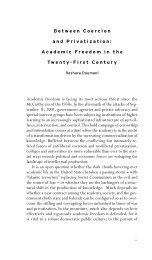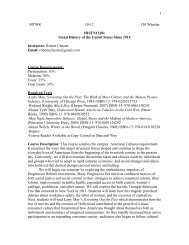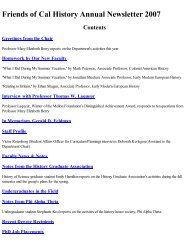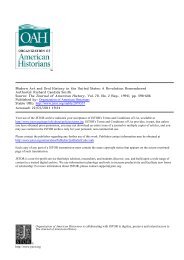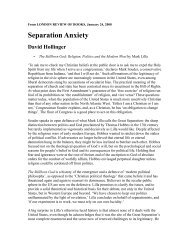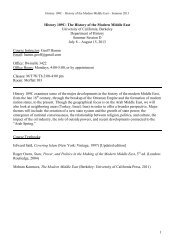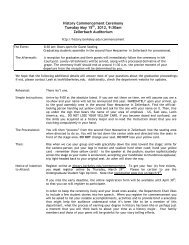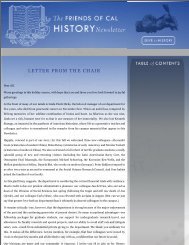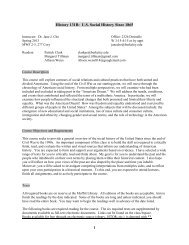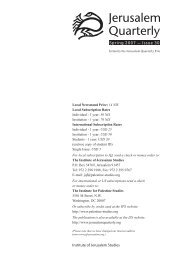David A. Hollinger | Amalgamation and Hypodescent: The Question ...
David A. Hollinger | Amalgamation and Hypodescent: The Question ...
David A. Hollinger | Amalgamation and Hypodescent: The Question ...
You also want an ePaper? Increase the reach of your titles
YUMPU automatically turns print PDFs into web optimized ePapers that Google loves.
slaveholders <strong>and</strong> the other white males in the vicinity were faithful to their wives. <strong>The</strong> principle wassharpened during the Jim Crow era, when opposition to social equality for blacks was of course wellserved by a monolithic notion of blackness accompanied by legislation that outlawed as miscegenationblack-white marriages but left less strictly regulated any non-marital sex in which white males mightengage with black females. As Tocqueville famously remarked well before the Civil War, "To debaucha Negro girl hardly injures an American's reputation; to marry her dishonors him." 26Some of the slave era <strong>and</strong> Jim Crow regimes did employ fractional classifications, providing that 18"Octoroons," "Quadroons," <strong>and</strong> "Mulattos" be separately counted <strong>and</strong> allowed distinctive rights <strong>and</strong>privileges in some jurisdictions. 27 But this fractional approach was hard to administer, invited litigation,<strong>and</strong> blurred lines that many whites wanted kept sharp. In 1894, Mark Twain's Pudd'nhead Wilsonmocked a law that stipulated as the fraction of black ancestry that decided one's race. 28 "Mulatto" wasdropped from the federal census after 1920, <strong>and</strong> more <strong>and</strong> more state governments went the way of theVirginia statute, which as revised in 1924 classified as white only a person "who has no tracewhatsoever of blood other than Caucasian." 29Criticism of this one-drop rule has surfaced from time to time, 30 but not until the 1990s did critical 19discussion of hypodescent become sustained <strong>and</strong> widespread in mainstream media. <strong>The</strong> lead in thisdiscussion was taken by persons at least some of whose white ancestry derives from recent voluntaryunions rather than from the legacy of the exploitation of slave women by white masters <strong>and</strong> overseers. 31But at stake is the degree of identity choice available to all black individuals whose measure ofwhiteness has been erased by law <strong>and</strong> convention. At stake, too, is the extent to which the United Statesas a whole will finally acknowledge the reality of the black-white mixing that has already taken place,<strong>and</strong> will thus be obliged to accept a fact long recognized by scholars: that blackness in the United Statesis an ascribed status, imposed on a spectrum of color shades <strong>and</strong> descent percentages, rather than acategory of nature. 32 At stake, further <strong>and</strong> most important, is the significance of blackness itself in thissociety. While there is a danger that the acceptance of mixture will ultimately reinforce white privilegeby treating as "white" all but the darkest, who might then be all the more isolated <strong>and</strong> subject toenduring prejudice, isn't there also a more hopeful prospect? <strong>The</strong> more that mixture is accepted, the lessfear there might be of what is being mixed. Blackness itself might become less stigmatized. If the onedroprule is an indicator of the depth of anti-black racism, might not the weakening of that rule be anindicator of the diminution of that racism? <strong>The</strong> present historical moment differs from previousepisodes of "whiting" in that now the very white-black distinction is being critically engaged rather thanreinforced <strong>and</strong> sharpened in the process of being relocated to render Jews, Italians, Mexicans, <strong>and</strong>others more clearly white <strong>and</strong> blacks more clearly black.<strong>The</strong> vigorous debate over the census classifications—should there be a box to check for mixed race, 20should an individual be able to check more than one box, <strong>and</strong> so forth—is only the most visible aspectof an unprecedented discursive episode in the history of American engagement with our question. Asociety that often has policed the black-white color line with terror now registers a more relaxedfascination with the crossing of that line, even widespread acceptance of such crossings. Hollywoodmovies explore the theme with increasing frequency, <strong>and</strong> family memoirs of black-white fusion fill thedisplay tables at bookstores. Some of these books—including James McBride's <strong>The</strong> Color of Water <strong>and</strong>Shirlee Taylor Haizlip's <strong>The</strong> Sweeter the Juice—have become bestsellers. 33 And among recent fictionbestsellers, Philip Roth's <strong>The</strong> Human Stain gives us the most artistically <strong>and</strong> morally ambitioustreatment of black-white mixing <strong>and</strong> of the multiple paradoxes of the one-drop rule offered by a whitenovelist since Mark Twain. 34 Organizations lobbying for greater recognition of ethnoracial mixtureproliferate, sponsor conferences, publish volume after volume, <strong>and</strong> now operate numerous web sites. 35DNA evidence lending support to the old suspicion that Thomas Jefferson fathered children with a slavemistress has stimulated sympathetic retellings of the Jefferson–Sally Hemings story that help mark thedifference between our time <strong>and</strong> even the very recent past, when the mere mention of Hemings was



